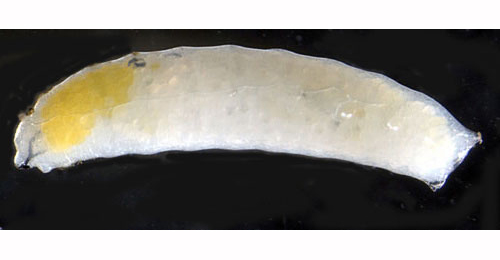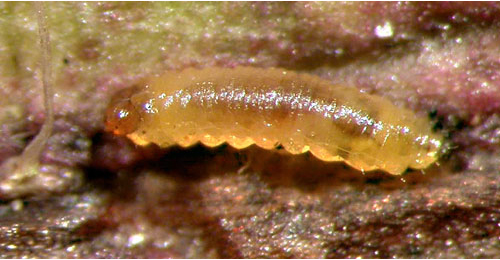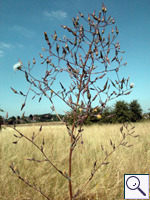|
||||||
|
LACTUCA. Lettuces. [Asteraceae] |
|
|
Seven species of Lactuca are recorded in Britain. These include the native Least Lettuce (L. saligna), Prickly Lettuce (L. serriola) and Great Lettuce (L. virosa) and the introduced Garden Lettuce (L. sativa) and Blue Lettuce (L. tatarica), Mountain Lettuce (L. perennis) and Pliant Lettuce (L. viminea). The BSBI provide a downloadable plant crib for Lactuca. Least Lettuce (L. saligna) is protected under Schedule 8 of the Wildlife and Countryside Act, 1981. Twelve or thriteen British miners are recorded on Lactuca. A key to the European miners recorded on Lactuca is provided in Bladmineerders van Europa. |
|
Key for the identification of the known mines of British |
|||
1a > Leaf-miner: A short, irregular, linear upper surface mine on any part of the leaf. Also recorded from young pods (Bland, 1997a). Long corridor mine. As a rule the first part of the mine is lower-surface, the later part upper-surface. Often the loops are so dense that a secondary blotch is the result. Because upper- and lower-surface corridor segments often cross, the mine obtains a strange array of transparant patches. There is no association with the midrib. Frass in strings and thread fragments. Pupation outside the mine; exit slit in upper epidermis. Mine not associated with the veins or midrib of the leaf (It is this character which enables distinction from another Agromyzid pest species - Liriomyza huidobriensis). The larvae may leave one leaf (if not large enough) and enter another leaf, via the petiole). It exits the leaf to pupate through a semi-circular slit in the upper surface of the leaf. |
|||
|
|||
Liriomyza bryoniae (Kaltenbach, 1858) [Diptera: Agromyzidae]. |
|||
1b > Leaf-miner: A small primary blotch, often several larvae feeding together (Spencer, 1972b: 56 (fig. 186); Spencer, 1976: 270, 271 (fig. 483)). Brown, upper-surfsce blotch; often several larvae in a mine. The blotch is preceded by a short initial corridor, often overrun by the later blotch. Frass in a few, small grains. Secondary feeding lines well visible. Pupation outside the mine, exit slit in upper epidermis. Small upper surface blotch, with occasional galleries leading from the blotch. Often several larvae feeding together. |
|||
 Liriomyza sonchi larva, lateral Image: © Willem Ellis (Bladmineerders van Europa) |
|||
|
|||
Liriomyza sonchi Hendel, 1931 [Diptera: Agromyzidae]. |
|||
1c > Leaf-miner: Mine linear, whitish, both upper and lower surface. Pupation internal, at the end of the mine with the anterior spiracles projecting through the epidermis (Spencer, 1976: 433). Upper-surface, less often lower-surface corridor. Frass in isolated grains. Pupation within the mine, in a, usually lower-surface, pupal chamber. A long whitish upper surface corridor, which eventually goes lower surface (British leafminers) |
|||
|
|||
Chromatomyia
horticola (Goureau, 1851) [Diptera: Agromyzidae] |
|||
1d > Leaf-miner: A distinctive mine primarily above mid-rib, with irregular short lateral offshoots into leaf blade. Pupation external (Spencer, 1972: 51 (fig. 172), 55; Spencer, 1976: 270, 271 (fig. 486)). Branched, whitish, upper-surface corridor; main axis overlying the midrib; side branches overlying the main lateral veins. (In Campanula and Phyteuma the mine is much less branched, sometimes nothing more than a corridor on top of the midrib). Frass in rather long strings. Usually the mines begins as a long and narrow, shallow, tortuous lower-surface corridor that ends upon the midrib but otherwise is not associated with the leaf venation. Often this initial corridor is filled with callus, and then even less conspicuous. Pupation outside the mine. A linear mine on the upper surface, usually following the midrib and showing side branches along the veins. The frass is in strings. |
|||
|
|||
|
|||
Liriomyza strigata (Meigen, 1830) [Diptera: Agromyzidae]. |
|||
1e > Leaf-miner: Larva initially forms a narrow lower surface linear mine, later producing a large blotch, frequently adjoining the leaf-margin on the upper surface. Several larva can feed together (Spencer, 1976: 269). Upper-surface blotch at the leaf margin, preceded by a lower-surface corridor. Most frass in the centre of the blotch. Often several larvae in a mine. Primary and secondary feeding lines well visible. Pupation outside the mine. |
|||
|
|||
Liriomyza scorzonerae Rydén, 1951 [Diptera: Agromyzidae] |
|||
1f > Leaf-miner: A white mine along mid-rib, with offshoots into leaf blade. Pupation internal at base of mid-rib. In Asteraceae the larva mostly lives as a borer in the midrib of the leaves. From there short corridors are made into the blade. Also a corridor can be made overlying the midrib. In Euphorbia a small mine is made in the bracts of the inflorescence. The final mine strongly resembles the one of Liriomyza strigata, but the branches are vritually free from frass; this is acccumulated in the resting place of the larva, in the base of the midrib. There also pupation takes place. Forms a mine along the midrib and has feeding spurs into the leaf. Pupation is in the mine at the base of the midrib. |
|||
|
|||
Ophiomyia beckeri (Hendel, 1923) [Diptera: Agromyzidae]. |
|||
1g > Leaf-miner: Egg is laid beneath the epidermis on the upper leaf surface. Larva mines in basal leaves. Pupation internal (Spencer, 1976: 74). Little branched corridors, radiating from the leaf base, often deep in the plant tissue. The larva can migrate from one leaf to the other through the petioles. Frass concentrated in the lowest, basal part of the mine; there also the pupation takes place. |
|||
|
|||
Ophiomyia pinguis (Fallén, 1820) [Diptera: Agromyzidae]. |
|||
1h > Larva mining both lower and upper surface, unusually long, linear, conspicuously broad, frequently largely on the underside of the leaf. Pupation external (Spencer, 1972b: 76 (fig. 251); Spencer, 1976: 445 (fig. 780), 446). Corridor mine. The first part consists of a very long and narrow lower-surface corridor; the mine is quite shollow here, and often inconspicuous. The second part is upper-surface, uusally much shorter, and widens abruptly. Pupation outside the mine. |
|||
|
|||
Phytomyza marginella Fallén, 1823 [Diptera: Agromyzidae]. |
|||
1i > Leaf-miner: The mine begins as a long, quite narrow corridor, usually not far from the tip of a leaf segment. Usually this corridor follows the leaf margin for some distance, but it may also run freely through the blade and may then be stongly contorted. In the end the corridor is directed towards the midrib, where an elongated blotch is formed, overlying the midrib and some of the larger lateral veins. Frass in a nearly continuous line in the initial corridor, in scattered lumps in the later part of the mine. Primary and secondary feeding lines very conspicuous when seen in transparancy. Pupation outside the mine. The mine starts as a very narrow corridor, usually close to the tip of a leaf segment and following the leaf margin. The later section of the corridor approaches the main vein, where an elongated blotch is made with long broad finger like extensions that lay over the secondary veins. In the initial corridor the frass forms an almost continuous line, in the blotch it is distributed in large scattered lumps. In fresh mines the secondary feeding lines are clearly visible. |
|||
|
|||
Trypeta zoe Meigen, 1826 [Diptera: Tephritidae]. |
|||
1j > Leaf-miner: In the first instar the larva mines the leaves, forming short, irregular, blotch-like mines, but in later instars it lives externally, feeding in spun leaves and often twisting those of tender shoots. Larval head light-brown or yellowish brown, edged with black postero-laterally, ocellar area blackish; prothoracic plate black edged with whitish anteriorly; abdomen dull dark green; pinacula distinct, black, sometimes brownish but with black bases to setae; anal plate large, black (Bradley et al., 1973). Small, full depth mine without a definite shape; little frass. Some silk is deposited in the mine. The larva soon leaves the mine and continues feeding among spun leaves. |
|||
|
|||
Cnephasia incertana (Treitschke, 1835) [Lepidoptera: Tortricidae]. |
|||
1k > Leaf-miner: The mine begins in the midrib, especially in a lower leaf, extending into the leaf disc, branching irregularly or pinnately, may also locally be blotch like. The mine is brown and very transparent. Sides very irregularly eaten out. Frass loosely dispersed or in a loose central line, buy may also be pressed against the sides of the corridor. The larva may also leave the mine and restart elsewhere. |
|||
 Orthochaetes setiger larva, dorsal Image: © Jean-Yves Baugnée (Bladmineerders van Europa) |
|||
|
|||
Orthochaetes setiger (Beck, 1817) [Coleoptera: Curculionidae]. |
|||
| Last updated 09-Jul-2020 Brian Pitkin | ||


